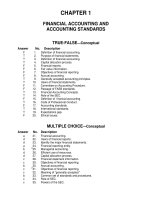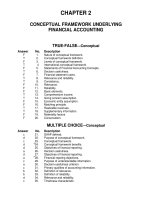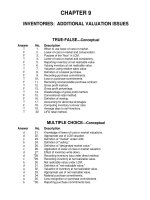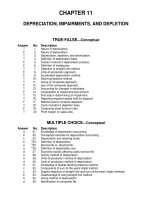Intermediate accounting 16e by kieso slide ch12
Bạn đang xem bản rút gọn của tài liệu. Xem và tải ngay bản đầy đủ của tài liệu tại đây (1.56 MB, 66 trang )
12-1
12
Intangible Assets
LEARNING OBJECTIVES
After studying this chapter, you should be able to:
1 Describe the characteristics,
valuation, and amortization of
intangible assets.
4 Explain impairment procedures
and presentation requirements
for intangible assets.
2 Describe the accounting for
various types of intangible
assets.
5 Describe accounting and
presentation for research and
development and similar costs.
3 Explain the accounting issues for
recording goodwill.
12-2
PREVIEW OF CHAPTER 12
12-3
Intermediate Accounting
16th Edition
Kieso ● Weygandt ● Warfield
INTANGIBLE ASSET ISSUES
Characteristics
The Coca-Cola Company’s
success comes from its secret
formula for making CocaCola, not
its plant facilities.
1. Lack physical existence.
2. Not financial instruments.
Normally classified as long-term asset.
Common types of intangibles:
12-4
Patents
Trademarks or trade names
Copyrights
Goodwill
Franchises or licenses
LO 1 Describe the characteristics, valuation,
and amortization of intangible assets.
INTANGIBLE ASSET ISSUES
Valuation
Purchased Intangibles
12-5
Recorded at cost.
Includes all costs necessary to make the intangible
asset ready for its intended use.
Typical costs include:
►
Purchase price.
►
Legal fees.
►
Other incidental expenses.
LO 1
INTANGIBLE ASSET ISSUES
Valuation
Internally Created Intangibles
Recorded at cost.
Generally expensed.
Only capitalize direct costs
incurred in developing the
intangible, such as legal costs.
Google expensed the R&D costs incurred to develop its
valuable search engine.
12-6
LO 1
INTANGIBLE ASSET ISSUES
Amortization of Intangibles
Limited-Life Intangibles
12-7
Amortize to expense over useful life.
Credit asset account or accumulated amortization.
Useful life should reflect the periods over which the asset
will contribute to cash flows.
Amortization should be cost less residual value.
Companies should evaluate the limited-life intangibles for
impairment.
LO 1
INTANGIBLE ASSET ISSUES
Amortization of Intangibles
Indefinite-Life Intangibles
12-8
No foreseeable limit on time the asset is expected to
provide cash flows.
Must test indefinite-life intangibles for impairment at
least annually.
No amortization.
LO 1
INTANGIBLE ASSET ISSUES
Amortization of Intangibles
ILLUSTRATION 12-1
Accounting Treatment for Intangibles
12-9
LO 1
WHAT DO THE NUMBERS MEAN? ARE ALL BRANDS THE SAME?
Does it matter how a company builds brand
value? In a word, yes. If the brand is
internally developed, its value does not
appear in the financial statements. This is
the case for The Coca-Cola Company,
whose brand value is estimated to be
roughly worth $79.2 billion but its balance
sheet values its “trademarks within definitelives” (i.e., brands) at just $6.7 billion. As
you are learning in this chapter, this
reporting results because the accounting
rules prohibit companies from recognizing
brands and many other “intangible” assets if
they created them themselves. In contrast,
when Procter & Gamble (P&G) acquired
Gillette in 2005, it realized an additional $24
billion in intangible assets on its balance
sheet. That is, P&G paid $57 billion for
Gillette and
12-10
estimated the Gillette brand value to be
worth $24 billion of the total paid.
Some
have
criticized
this
inconsistency in accounting, noting that
information about the value of a brand is
important to investors in consumerproduct companies. Those supporting the
difference in accounting cite the difficulty
in arriving at reliable estimates of
internally generated intangible assets.
This latter argument seems to be carrying
the day in support of the current
accounting, under which only purchased
brands and other intangible assets are
recognized in accounting reports.
Source: “Untouchable Intangibles: Sometimes
You See Brands on the Balance Sheet,
Sometimes You Don’t,” The Economist (August
30, 2014).
LO 1
TYPES OF INTANGIBLE ASSETS
Six Major Categories:
12-11
1.
Marketing-related.
4.
Contract-related.
2.
Customer-related.
5.
Technology-related.
3.
Artistic-related.
6.
Goodwill.
LO 2 Describe the accounting for various
types of intangible assets.
TYPES OF INTANGIBLE ASSETS
Marketing-Related Intangible Assets
Examples:
►
12-12
Trademarks or trade names, newspaper
mastheads, Internet domain names, and noncompetition agreements.
In the United States trademarks or trade names
have legal protection for indefinite number of 10
year renewal periods.
Capitalize acquisition costs.
No amortization.
LO 2
WHAT DO THE NUMBERS MEAN? KEEP YOUR HANDS OFF MY INTANGIBLES?
Companies go to great extremes to protect
their valuable intangible assets. Consider
how the creators of the highly successful
game Trivial Pursuit protected their creation.
First, they copyrighted the 6,000 questions
that are at the heart of the game. Then they
shielded the Trivial Pursuit name by
applying for a registered trademark. As a
third mode of protection, they obtained a
design patent on the playing board’s design
as a unique graphic creation.
Another more recent example is the
case of Converse and its efforts to protect
its classic Chuck Taylor trademark.
Converse (owned by Nike) accused 31
companies (including Wal-Mart Stores Inc.,
Kmart, and Skechers) of trademark
infringement for co-opting its widely
recognizable Chuck
12-13
Taylor® sneakers. While Converse is
suing for monetary damages, its main
goal is to get these imposters off store
shelves. The company went as far as
filing a separate complaint with the
International Trade Commission to stop
any shoes considered to be counterfeit
from entering the country. That Converse
(Nike) is going to these ends to protect its
trademark is understandable given the
Nike reinvigorated the brand by
expanding the franchise, introducing
more colors and styles, and helping to
push All Stars® into overseas markets.
Source: “Converse Sues to Product Its
Chuck Taylor All Stars,” The New
Work Times (October 14, 2014).
LO 2
TYPES OF INTANGIBLE ASSETS
Customer-Related Intangible Assets
Examples:
►
12-14
Customer lists, order or production backlogs, and both
contractual and non-contractual customer
relationships.
Capitalize acquisition costs.
Amortized to expense over useful life.
LO 2
TYPES OF INTANGIBLE ASSETS
Illustration: Green Market Inc. acquires the customer list of a
large newspaper for $6,000,000 on January 1, 2017. Green
Market expects to benefit from the information evenly over a
three-year period. Record the purchase of the customer list and
the amortization of the customer list at the end of each year.
12-15
Jan. 1
2017
Customer List 6,000,000
Dec. 31
2017
2018
2019
Amortization Expense 2,000,000
Cash
6,000,000
Customer List *
* or Accumulated Amortization
2,000,000
LO 2
TYPES OF INTANGIBLE ASSETS
Artistic-Related Intangible Assets
Examples:
►
Plays, literary works, musical works, pictures,
photographs, and video and audiovisual material.
Copyright granted for the life of the creator plus 70
years.
Capitalize costs of acquiring and defending.
Amortized to expense over useful life.
and
12-16
Mickey
Mouse
LO 2
TYPES OF INTANGIBLE ASSETS
Contract-Related Intangible Assets
Examples:
►
12-17
Franchise and licensing agreements, construction
permits, broadcast rights, and service or supply
contracts.
Franchise (or license) with a limited life should be
amortized to expense over the life of the franchise.
Franchise with an indefinite life should be carried at
cost and not amortized.
LO 2
TYPES OF INTANGIBLE ASSETS
Technology-Related Intangible Assets
Examples:
►
12-18
Patented technology and trade secrets granted by
the U.S. Patent and Trademark Office.
Patent gives holder exclusive use for 20 years.
Capitalize costs of purchasing a patent.
Expense any R&D costs in developing a patent.
Amortize over legal life or useful life, whichever is
shorter.
LO 2
WHAT DO THE NUMBERS MEAN? PATENT BATTLES?
The smartphone industry has been a patent
battleground. For example, Nokia filed
patent lawsuits against Apple (and Apple
countersued) over cell phone features such
as swiping gestures on touch screens and
the “app store” for downloading software.
Apple also targeted HTC for infringing on
Apple’s patented feature that allows screens
to detect more than one finger touch at a
time. This facilitates the popular zoom-in
and zoom-out capability. HTC, in turn, sued
Apple for infringing on patented technology
that helps extend battery life. The activitytracker product space is another patent
battleground. Competition in that market
heated up when Under Armour recently
paid $150 million to acquire MapMyFitness,
which has 20 million people registered to
use its websites and mobile applications to
12-19
map, record, and share their workouts. To
protect the value of the patent related to
its miCoach fitness tracking system,
adidas AG sued Under Armour. The
lawsuit alleges that Under Armour
infringed
on 10
adidas patents,
underscoring the growing importance of
gadgetry and personal technology for
sportswear makers that traditionally
focused on shoes and apparel.
Sources: J. Mintz, “Smart Phone Makers in
Legal Fights over Patents,” Wisconsin State
Journal (December 19, 2010), p. F4; and S.
Germano, “Adidas Sues Under Armour Over
Patents: Company Alleges Under Armour
Infringes on 10 MiCoach Patents,” Wall
Street Journal (February 4, 2014).
LO 2
TYPES OF INTANGIBLE ASSETS
Illustration: Harcott Co. incurs $180,000 in legal costs on
January 1, 2017, to successfully defend a patent. The patent’s
useful life is 12 years, amortized on a straight-line basis. Harcott
records the legal fees and the amortization at the end of 2017 as
follows.
Jan. 1
Patents
Cash
180,000
180,000
Dec. 31 Amortization Expense 15,000
Patents (or Accumulated Amortization)
12-20
15,000
LO 2
WHAT DO THE NUMBERS MEAN? VALUE OF SECRET FORMULA?
After several espionage cases were
uncovered, the secrets contained within the
Los Alamos nuclear lab seemed easier to
check out than a library book. But The
Coca-Cola Company has managed to keep
the recipe for the world’s best-selling soft
drink under wraps for more than 100 years.
The company offers almost no information
about its lifeblood, and the only written copy
of the formula resides in a bank vault in
Atlanta. This handwritten sheet is available
to no one except by vote of Coca-Cola’s
board of directors.
Can’t science offer some clues? Coke
purportedly contains 17 to 18 ingredients.
That includes the usual caramel color and
corn syrup, as well as a blend of oils known
as 7X (rumored to be a mix of orange,
lemon, cinnamon, and others).
12-21
Distilling natural products like these is
complicated since they are made of
thousands of compounds. One ingredient
you will not find, by the way, is cocaine.
Although the original formula did contain
trace amounts, today’s Coke doesn’t.
When was it removed? That too is a
secret.
Some experts indicate that the power
of the Coca-Cola formula and related
brand image account for almost $79.2
billion, or roughly 43 percent, of Coke’s
$182.2 billion stock value.
Sources: Adapted from Reed Tucker, “How
Has Coke’s Formula Stayeda Secret?”
Fortune (July 24, 2000), p. 42; and “Best
Global Brands 2011,” www.interbrand.com
(accessed August 30, 2014).
LO 2
TYPES OF INTANGIBLE ASSETS
Goodwill
Conceptually, represents the future economic benefits arising
from the other assets acquired in a business combination that
are not individually identified and separately recognized.
Only recorded when an entire business is purchased.
Goodwill is measured as the ...
excess of cost of the purchase over the FMV of the
identifiable net assets (assets less liabilities) purchased.
Internally created goodwill
should not be capitalized.
12-22
LO 3 Explain the accounting issues
for recording goodwill.
Recording Goodwill
Illustration: Multi-Diversified, Inc. decides that it needs a parts
division to supplement its existing tractor distributorship. The
president of Multi-Diversified is interested in buying Tractorling
Company. The illustration presents the statement of financial
position of Tractorling Company.
ILLUSTRATION 12-3
Tractorling Co. Balance Sheet
12-23
LO 3
Recording Goodwill
Multi-Diversified investigates Tractorling’s underlying assets to
determine their fair values.
ILLUSTRATION 12-4
Fair Value of Tractorling’s Net Assets
12-24
LO 3
Recording Goodwill
Tractorling Company decides to accept Multi-Diversified’s offer of
$400,000. What is the value of the goodwill, if any?
ILLUSTRATION 12-5
Determination of Goodwill—Master Valuation Approach
12-25
LO 3









